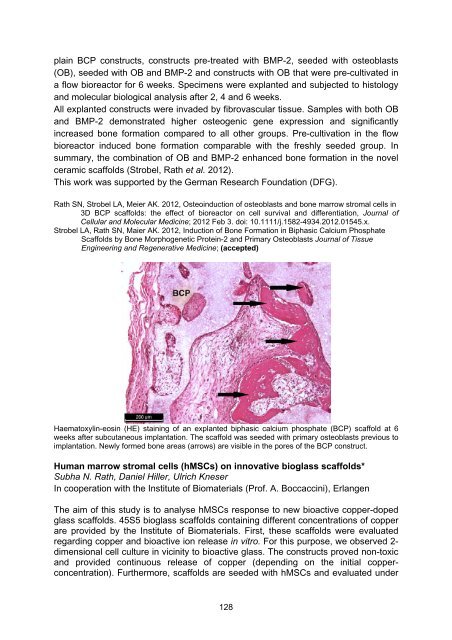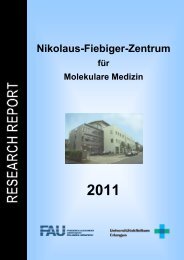Research Report - Nikolaus-Fiebiger-Zentrum für Molekulare Medizin
Research Report - Nikolaus-Fiebiger-Zentrum für Molekulare Medizin
Research Report - Nikolaus-Fiebiger-Zentrum für Molekulare Medizin
Create successful ePaper yourself
Turn your PDF publications into a flip-book with our unique Google optimized e-Paper software.
plain BCP constructs, constructs pre-treated with BMP-2, seeded with osteoblasts<br />
(OB), seeded with OB and BMP-2 and constructs with OB that were pre-cultivated in<br />
a flow bioreactor for 6 weeks. Specimens were explanted and subjected to histology<br />
and molecular biological analysis after 2, 4 and 6 weeks.<br />
All explanted constructs were invaded by fibrovascular tissue. Samples with both OB<br />
and BMP-2 demonstrated higher osteogenic gene expression and significantly<br />
increased bone formation compared to all other groups. Pre-cultivation in the flow<br />
bioreactor induced bone formation comparable with the freshly seeded group. In<br />
summary, the combination of OB and BMP-2 enhanced bone formation in the novel<br />
ceramic scaffolds (Strobel, Rath et al. 2012).<br />
This work was supported by the German <strong>Research</strong> Foundation (DFG).<br />
Rath SN, Strobel LA, Meier AK. 2012, Osteoinduction of osteoblasts and bone marrow stromal cells in<br />
3D BCP scaffolds: the effect of bioreactor on cell survival and differentiation, Journal of<br />
Cellular and Molecular Medicine; 2012 Feb 3. doi: 10.1111/j.1582-4934.2012.01545.x.<br />
Strobel LA, Rath SN, Maier AK. 2012, Induction of Bone Formation in Biphasic Calcium Phosphate<br />
Scaffolds by Bone Morphogenetic Protein-2 and Primary Osteoblasts Journal of Tissue<br />
Engineering and Regenerative Medicine; (accepted)<br />
Haematoxylin-eosin (HE) staining of an explanted biphasic calcium phosphate (BCP) scaffold at 6<br />
weeks after subcutaneous implantation. The scaffold was seeded with primary osteoblasts previous to<br />
implantation. Newly formed bone areas (arrows) are visible in the pores of the BCP construct.<br />
Human marrow stromal cells (hMSCs) on innovative bioglass scaffolds*<br />
Subha N. Rath, Daniel Hiller, Ulrich Kneser<br />
In cooperation with the Institute of Biomaterials (Prof. A. Boccaccini), Erlangen<br />
The aim of this study is to analyse hMSCs response to new bioactive copper-doped<br />
glass scaffolds. 45S5 bioglass scaffolds containing different concentrations of copper<br />
are provided by the Institute of Biomaterials. First, these scaffolds were evaluated<br />
regarding copper and bioactive ion release in vitro. For this purpose, we observed 2dimensional<br />
cell culture in vicinity to bioactive glass. The constructs proved non-toxic<br />
and provided continuous release of copper (depending on the initial copperconcentration).<br />
Furthermore, scaffolds are seeded with hMSCs and evaluated under<br />
128



